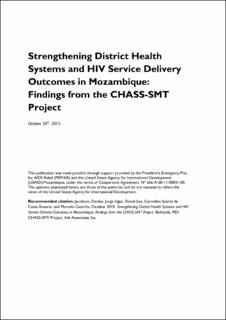| dc.description.abstract | Introduction : While there is growing consensus within the global health community on the importance of health systems strengthening (HSS) to improving service delivery and health outcomes, evidence linking HSS interventions to such outcomes is only beginning to emerge. This study sought to examine the relationships between the District Approach intervention in Mozambique and HIV service delivery outcomes, as well as the relationship between strengthened district health systems and HIV service delivery outcomes. Intervention : The Clinical HIV/AIDS Services Strengthening Project in Sofala, Manica, and Tete provinces (CHASS-SMT) designed the District Approach to address key weaknesses that lead to underperformance of districts on HIV service delivery: low managerial capacity; scarcity of resources; and sub-optimal systems and processes. District Approach interventions included the Graduation Path, district sub-agreements, and clinical tutoring. The goal of the Graduation Path was to improve the capacity of districts to manage systemic functions (planning, information systems, human resources, financing, supply and logistics) and services functions (health programs, laboratory, community mobilization). The Graduation Path included a periodic, quantitative assessment of district management capacity based on process indicators. Methods : CHASS-SMT implemented the District Approach differently among the 36 districts in Sofala, Manica, and Tete: twelve high-priority districts (HPDs) received the full package, including the Graduation Path, and the remaining 24 non-priority districts (NPDs) received a less intensive form of the District Approach, which did not include the Graduation Path. We used the Graduation Path scores to measure changes in district management capacity, and six facility-level HIV services indicators to measure service delivery outcomes: three quality indicators and three access indicators. We used both bivariate (mean comparison) and multivariate a | |
